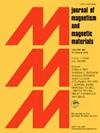Single-molecule Magnets (SMM) spin channels connecting FeMn antiferromagnet and NiFe ferromagnetic electrodes of a tunnel junction
IF 2.5
3区 材料科学
Q3 MATERIALS SCIENCE, MULTIDISCIPLINARY
引用次数: 0
Abstract
The integration of single-molecule magnets (SMMs) into magnetic tunnel junctions (MTJs) offers significant potential for advancing molecular spintronics, particularly for next-generation memory devices, quantum computing, and energy storage technologies such as solar cells. In this study, we present the first demonstration of SMM-induced spin-dependent properties in an antiferromagnet-based MTJ molecular spintronic device (MTJMSD). We engineered cross-junction-shaped devices comprising FeMn/AlOx/NiFe MTJs. The AlOx barrier thickness where the exposed junction edges meet was comparable to the SMM length, facilitating the incorporation of SMM molecules as spin channels for spin-dependent transport. The SMM channels enabled long-range magnetic moment ordering around molecular junctions, which were precisely engineered via fabrication processes. The SMM, composed of a [Mn6(μ3-O)2(H2N-sao)6(6-atha)2(EtOH)6] (H2N-saoH = salicylamidoxime, 6-atha = 6-acetylthiohexanoate) complex, featured thioester groups at the ends that upon hydrolysis they form bonds with the magnetic electrodes. SMM-treated junctions demonstrated a significant current enhancement, reaching up to 7 μA at an input voltage of 60 mV. Furthermore, SMM-doped junctions exhibited current stabilization in the μA range at lower temperatures, whereas the bare electrodes showed current suppression to the picoampere range. Magnetization measurements conducted at 55 K and 300 K on pillar-shaped devices revealed a reduction in magnetic moment at low temperatures. Additionally, Kelvin probe atomic force microscopy (KPAFM) measurements confirmed that SMM integration transformed the electronic properties over long ranges.These findings are attributed to the spin channels formed between magnetic metal electrodes, which enhance spin polarization at each magnetic electrode. Our research highlights the potential of using antiferromagnetic materials, characterized by minimal stray fields and zero net magnetization, to transform MTJMSD devices.
连接隧道结的铁锰反铁磁体和镍铁铁磁电极的单分子磁体 (SMM) 自旋通道
将单分子磁体(SMM)集成到磁隧道结(MTJ)中为推动分子自旋电子学的发展提供了巨大的潜力,特别是在下一代存储器件、量子计算和太阳能电池等储能技术方面。在这项研究中,我们首次在基于反铁磁体的 MTJ 分子自旋电子器件(MTJMSD)中展示了 SMM 诱导的自旋相关特性。我们设计了由铁锰/氧化铝/镍铁合金 MTJ 组成的交叉结形器件。在暴露的结边缘相接处的氧化铝阻挡层厚度与 SMM 长度相当,这有利于将 SMM 分子作为自旋通道纳入自旋相关传输。SMM 通道可在分子结周围实现长程磁矩排序,而分子结是通过制造工艺精确设计的。由[Mn6(μ3-O)2(H2N-sao)6(6-atha)2(EtOH)6](H2N-saoH = 水杨酰胺肟,6-atha = 6-乙酰硫代己酸酯)复合物组成的 SMM 在末端具有硫酯基团,水解后会与磁极形成键合。经 SMM 处理的结电流明显增强,在输入电压为 60 mV 时电流高达 7 μA。此外,掺杂 SMM 的结在较低温度下电流稳定在 μA 范围内,而裸电极的电流抑制在皮安培范围内。在 55 K 和 300 K 下对柱形器件进行的磁化测量显示,低温下磁矩减小。此外,开尔文探针原子力显微镜(KPAFM)测量证实,SMM 集成改变了远距离的电子特性。这些发现归功于磁性金属电极之间形成的自旋通道,它增强了每个磁性电极的自旋极化。我们的研究凸显了使用反铁磁材料改造 MTJMSD 器件的潜力,反铁磁材料的特点是杂散磁场最小、净磁化为零。
本文章由计算机程序翻译,如有差异,请以英文原文为准。
求助全文
约1分钟内获得全文
求助全文
来源期刊

Journal of Magnetism and Magnetic Materials
物理-材料科学:综合
CiteScore
5.30
自引率
11.10%
发文量
1149
审稿时长
59 days
期刊介绍:
The Journal of Magnetism and Magnetic Materials provides an important forum for the disclosure and discussion of original contributions covering the whole spectrum of topics, from basic magnetism to the technology and applications of magnetic materials. The journal encourages greater interaction between the basic and applied sub-disciplines of magnetism with comprehensive review articles, in addition to full-length contributions. In addition, other categories of contributions are welcome, including Critical Focused issues, Current Perspectives and Outreach to the General Public.
Main Categories:
Full-length articles:
Technically original research documents that report results of value to the communities that comprise the journal audience. The link between chemical, structural and microstructural properties on the one hand and magnetic properties on the other hand are encouraged.
In addition to general topics covering all areas of magnetism and magnetic materials, the full-length articles also include three sub-sections, focusing on Nanomagnetism, Spintronics and Applications.
The sub-section on Nanomagnetism contains articles on magnetic nanoparticles, nanowires, thin films, 2D materials and other nanoscale magnetic materials and their applications.
The sub-section on Spintronics contains articles on magnetoresistance, magnetoimpedance, magneto-optical phenomena, Micro-Electro-Mechanical Systems (MEMS), and other topics related to spin current control and magneto-transport phenomena. The sub-section on Applications display papers that focus on applications of magnetic materials. The applications need to show a connection to magnetism.
Review articles:
Review articles organize, clarify, and summarize existing major works in the areas covered by the Journal and provide comprehensive citations to the full spectrum of relevant literature.
 求助内容:
求助内容: 应助结果提醒方式:
应助结果提醒方式:


